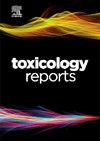An evaluation and risk assessment of children’s exposures to water-soluble per- and polyfluoroalkyl substances through winter gloves
Q1 Environmental Science
引用次数: 0
Abstract
Winter gloves are often treated with fluoroacrylic surface coatings containing per- and polyfluoroalkyl substances (PFAS) to enhance water resistance. Concern over exposure to water-soluble PFAS, those with the greatest toxicological and regulatory relevance, has grown, particularly for children, who may experience higher relative body burdens due to lower body weight and frequent hand-to-mouth behaviors. In this study, we characterized the PFAS content and migration potential of winter gloves and conducted a screening-level risk assessment of perfluorooctanoic acid (PFOA) and perfluorohexanoic acid (PFHxA) glove exposures in children aged 2–6, considering both hand-to-mouth transfer and dermal absorption. Experimental data were generated through total fluorine analysis, liquid chromatography–tandem mass spectrometry (LC-MS/MS), gas chromatography–tandem mass spectrometry (GC-MS/MS), and leachate testing of individual glove components across eight glove brands. Three fluorotelomer compounds were detected above the limits of detection in 6 out of 173 components, spanning 3 of the 8 brands. No PFAS were detected in leachate samples, suggesting negligible migration under simulated use conditions. The calculated oral, dermal, and cumulative hazard indices, based on conservative, low-exposure scenarios using estimated concentrations below the detection limit, were all well below 0.001. This study contributes to the evidence base for PFAS risk assessment in consumer products and demonstrates that detectable PFAS residues do not necessarily translate to meaningful exposure or health risk. These findings support the use of risk-based regulatory approaches that incorporate realistic exposure scenarios in the evaluation of PFAS in treated textiles.
儿童通过冬季手套接触水溶性全氟烷基和多氟烷基物质的评估和风险评估
冬季手套通常用含有全氟烷基和多氟烷基物质(PFAS)的氟丙烯酸表面涂层处理,以增强防水性能。由于水溶性PFAS具有最大的毒理学和监管相关性,人们对其暴露的关注日益增加,特别是对于儿童,由于体重较轻和频繁的手对嘴行为,他们可能会经历较高的相对身体负担。在这项研究中,我们对冬季手套的PFAS含量和迁移潜力进行了表征,并对2-6岁儿童的全氟辛酸(PFOA)和全氟己酸(PFHxA)手套暴露进行了筛查水平的风险评估,同时考虑了手到口转移和皮肤吸收。实验数据通过总氟分析、液相色谱-串联质谱(LC-MS/MS)、气相色谱-串联质谱(GC-MS/MS)和渗滤液检测生成,检测的是8个手套品牌的单个手套成分。在173种成分中,有6种含氟端粒化合物的检测结果超过了检测限度,涉及8个品牌中的3个。在渗滤液样品中未检测到PFAS,表明在模拟使用条件下迁移可以忽略不计。在使用低于检出限的估计浓度的保守、低暴露情景下计算的口腔、皮肤和累积危害指数均远低于0.001。本研究为消费品中PFAS风险评估提供了证据基础,并表明可检测到的PFAS残留不一定转化为有意义的接触或健康风险。这些发现支持使用基于风险的监管方法,将实际暴露情景纳入经处理纺织品中PFAS的评估。
本文章由计算机程序翻译,如有差异,请以英文原文为准。
求助全文
约1分钟内获得全文
求助全文
来源期刊

Toxicology Reports
Environmental Science-Health, Toxicology and Mutagenesis
CiteScore
7.60
自引率
0.00%
发文量
228
审稿时长
11 weeks
 求助内容:
求助内容: 应助结果提醒方式:
应助结果提醒方式:


